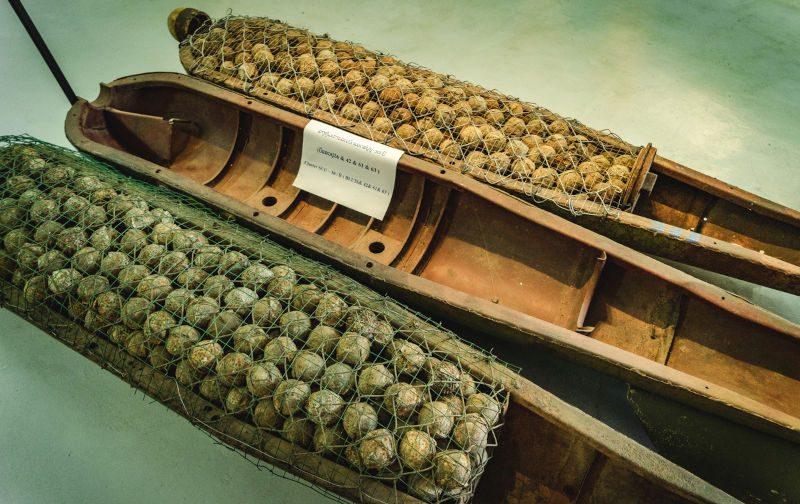American cluster bombs in Ukraine
July 11, 2023
According to the UN Human Rights Office, 9,083 civilians have been killed in 500 days of fighting in Ukraine, and 15,779 wounded. These figures are likely to increase dramatically once American cluster munitions are deployed.
Invented by Germany and deployed in World War Two, cluster bomb technology spread to the United States, Russia and Italy by wars end. By 1990, 34 countries were making them. Released from larger bombs dropped from aircraft, or from ground-fired artillery shells, small cluster bombs were designed to be scattered in their hundreds or thousands across enemy terrain. Some were designed to destroy enemy armour, materiel, or electrical installations, or used as incendiaries. But most were aimed to kill soft targets such as human beings, usually enemy combatants.
Among many such deployments, the United States dropped thousands of cluster bombs during its numerous post-WW2 engagements, including in Vietnam, Laos, and Cambodia in the 1960s, and in Iraq during Operation Iraqi Freedom in 2003. No doubt, US-made cluster bombs were also deployed in numerous US efforts to overthrow governments in Latin America between 1954 (Guatemala), and Nicaragua (1987).
The Soviet Union deployed them, notably in Afghanistan in the 1980s and during the first Chechen War in 1995. Britain used them against Argentina in the Falklands War in 1982. Israel has dropped them on numerous occasions in Syria, Iran, Lebanon and among Palestinians.
Warfare kills civilians in what perpetrators euphemistically call collateral damage. But cluster munitions are particularly terrible because 20 to 40 percent of them dont detonate immediately, but days, weeks, months or even years later, often to explode among civilians with devastating results. For example, fifty years after the Indo-Chinese conflict hundreds of farmers are still being killed in Laos, Cambodia and Vietnam as their ploughs bump into thousands of unexploded American bomblets buried in their paddy fields. Such accidents have been particularly numerous in Xiang Khuoang Province in Laos, and Quang Tri Province in Vietnam.
Growing horror at the mindless destructiveness of cluster bombs prompted the international community to negotiate a Convention on Cluster Munitions. It was adopted in Dublin in May 2008, and signed into law in Oslo in August 2010. It bans the use, production, trade or stockpiling of cluster munitions. The Convention has been adopted by 110 nations with 13 additional signatories. Regrettably, the United States and Ukraine are not amongst them. Nor are China, Russia, India, Pakistan and the Republic of Korea.
Now, as part of Americas program of support for Ukraine, President Biden has announced that the United States will supply cluster munitions for deployment against Russia. He claims he has had to do so because Ukraine is running out of regular artillery ammunition in its present counter-offensive against Russian forces in Luhansk and Zaporizhzhia. The counter-offensive is invested with much significance, aimed at driving a wedge between Russian forces in the Donbas and Crimea, a crucial step towards President Zelenskys hope to expel Russia from the country.
President Biden has met with protests from many signatories to the Convention, including Britain, Canada and Spain. He has responded defensively by saying that everything must be done to prevent use of cluster bombs against civilian targets, and that the so-called dud rate of the American-made bombs will be no more than 2.35 percent. It might just be possible that the US manufacturer of the cluster munitions has made such fine dud rate calibrations. But given Ukraines past atrocities against civilian targets in the Donbas, it is unlikely that Zelensky or his forces will be able or willing to abide by Bidens demand that no civilians will be targeted.
What about Australia? We have traditionally prided ourselves at being in the forefront of anti-war conventions. We were one of the first countries to sign the Nuclear Non-Proliferation Treaty in 1970, followed by the Treaties against Chemical and Biological Weapons and Mines in 1993, and the Arms Trade Treaty in 2013.
Australia also signed the Convention on Cluster Munitions in 2012, and has coordinated the Conventions victim assistance work since September 2014, as well as working to universalise the Conventions practices in the Asia-Pacific region ever since.
We have condemned the use of cluster munitions in South Sudan, Syria, and by Ukrainian forces in their own country in 2015. Curiously however, we do not yet appear to have condemned President Bidens decision to supply Ukrainian forces with cluster bombs this time around. Does the governments refusal to condemn them fit in the same category as Australias reluctance to sign the Treaty on the Prohibition of Nuclear Weapons, which Washington says would not allow US forces to exercise extended deterrence? Is it, depressingly, one more example of where Australia is forfeiting its sovereign right to make decisions that benefit this country? Are we simply too afraid to irritate Washington? What does it reveal about Australias selective disregard for international law-based order?
